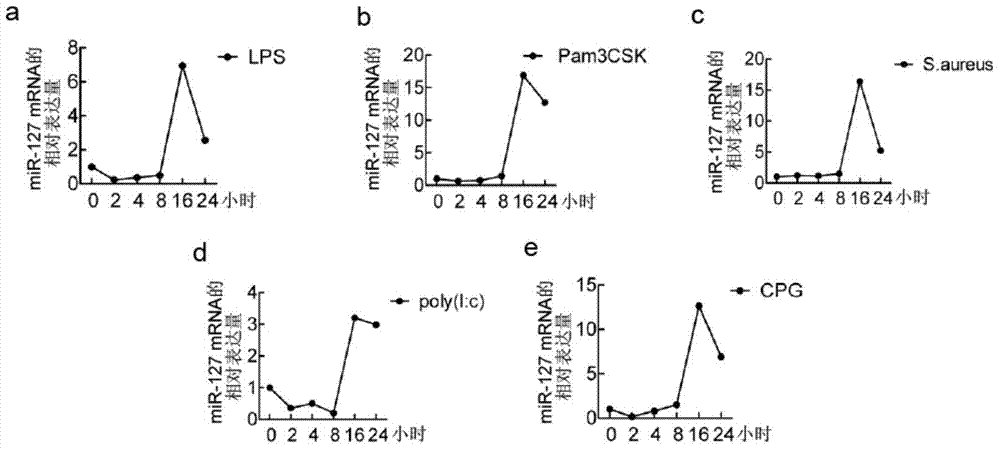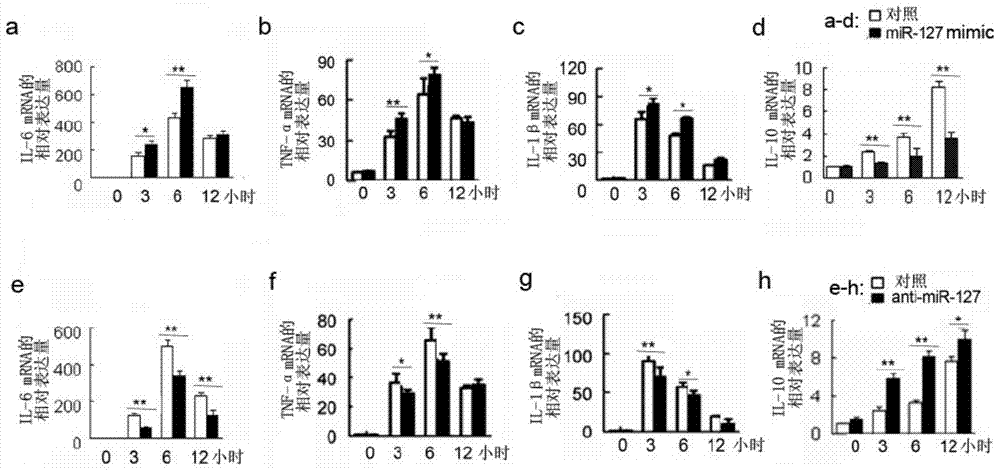Application of mir‑127 inhibitors in anti-inflammatory and lung injury protection drugs
A 1. mir-127, anti-mir-127 technology, applied in the field of biomedicine, can solve the problem of unclear and imperfect research on the immune response regulation mechanism, so as to reduce the production of pro-inflammatory factors and weaken the inflammatory response. , The effect of preventing lung inflammation and damage
- Summary
- Abstract
- Description
- Claims
- Application Information
AI Technical Summary
Problems solved by technology
Method used
Image
Examples
Embodiment 1
[0033] Example 1: miR-127 can be activated by the LPS-TLR4-NF-κB signaling pathway
[0034] (1) Expression of miR-127 stimulated by different TLR ligands
[0035] First, we stimulated primary mouse peritoneal macrophages with TLR4 ligand LPS (100ng / mL), collected cells at 0, 2, 4, 8, 16, and 24 hours after stimulation, extracted RNA and reverse transcribed , Quantitative polymerase chain reaction (polymerase chain reaction, PCR) method was used to detect the dynamic changes of miR-127 expression level in macrophages. The results indicated that the activation of TLR4 could activate the expression of miR-127. The expression of miR-127 first decreased after 2 hours of LPS stimulation, down to 10-20% of the base value; then increased rapidly, and the expression of miR-127 was the highest after 16 hours of stimulation, up to 7 times of the base value around; then began to decline ( figure 1 a).
[0036] The above results prove that miR-127 can be activated by the LPS-TLR4 signa...
Embodiment 2
[0040] Example 2: miR-127 regulates the expression of inflammatory factors and the polarity transformation of macrophages
[0041] (1) The effect of miR-127 on the production of IL-6, TNF-α, IL-1β and IL-10 in macrophages activated by LPS
[0042] We examined the mRNA and protein levels of TLR4-triggered macrophage production of inflammatory and effector cytokines. Mouse primary macrophages were transfected with miR-127mimic and anti-miR-127 for 24 hours, stimulated with LPS (100ng / mL), collected cells at 0, 3, 6, and 12 hours after stimulation, extracted RNA and reacted Transcription, quantitative PCR method was used to detect the gene transcription levels of IL-6 and TNF-α. The results showed that after TLR4 activation in the control group, the gene transcription levels of IL-6 and TNF-α in macrophages reached the highest peak at 6 hours. 6 gene transcription levels ( image 3 a), the gene transcription levels of TNF-α and IL-1β also showed a certain upward trend ( imag...
Embodiment 3
[0052] Example 3: Bcl6 is the target gene of miR-127
[0053] (1) Expression of Bcl6 in LPS-stimulated macrophages
[0054] Through bioinformatics analysis, we found that there may be a specific target site paired with the miR-127 seed sequence region in the 3'UTR region of Bcl6. Subsequently, we stimulated mouse peritoneal macrophages with LPS (100ng / mL), collected cells at 0, 1, 2, 3, 4, and 12 hours after stimulation, prepared protein samples as described in the method section, and detected them by Western blot Changes in protein expression of Bcl6. The results showed that the expression of Bcl6 increased with the stimulation of LPS, and the expression was the highest at 2 hours, and then gradually weakened as the stimulation time increased. Compared with the previous experimental results, it shows that the protein change of LPS-induced Bcl6 and the expression of miR-127 just show the opposite expression law, which suggests that miR-127 may be involved in the expression r...
PUM
 Login to View More
Login to View More Abstract
Description
Claims
Application Information
 Login to View More
Login to View More - R&D
- Intellectual Property
- Life Sciences
- Materials
- Tech Scout
- Unparalleled Data Quality
- Higher Quality Content
- 60% Fewer Hallucinations
Browse by: Latest US Patents, China's latest patents, Technical Efficacy Thesaurus, Application Domain, Technology Topic, Popular Technical Reports.
© 2025 PatSnap. All rights reserved.Legal|Privacy policy|Modern Slavery Act Transparency Statement|Sitemap|About US| Contact US: help@patsnap.com



